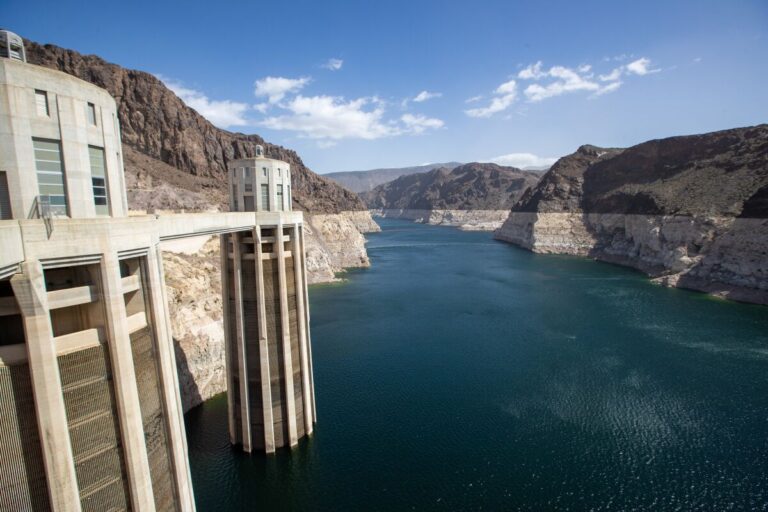Photo: Concrete intake towers revealed by receding Lake Mead behind Hoover Dam in Nevada. (Brian van der Brug/Los Angeles Times)
In the long sweep of human history, water has always played a central role in determining the geography of civilizations, and eons ago it influenced the migration of our early ancestors out of Africa and across the world. The ability to manage water contributed to the success or failure of empires along the Tigris and Euphrates rivers of the Middle East, the Indus in southern Asia, and the Yangtze in China. This First Age of water saw the earliest efforts to manipulate water with dams, aqueducts and intentional irrigation, and also the first water laws, institutions and water conflicts.
As human populations and economies outgrew local water resources, a new age led to revolutions in science, engineering, medicine and knowledge. During this Second Age of water, we uncovered the chemical, physical and biological nature of water, improved our ability to understand and control the hydrologic cycle, learned about the causes and cures for water-related diseases and built the agricultural systems that let us feed and support today’s 8 billion people. We now have the technology to produce the cleanest water from the most contaminated, purify and recycle water to support astronauts on the space station and launch instruments and robotic explorers into the far reaches of the solar system, often looking for water.
But this second age has also led to unintended consequences: the overuse and contamination of rivers, lakes, groundwater and oceans; worsening inequality of resource use; the destruction of aquatic ecosystems; and climate change, which affects the waters of the planet.
The U.S. today uses less water for everything than it did 40 years ago, despite a larger population and economy — a sign we’re moving in the right direction.
These interlocking crises are slow moving. They are often subtle or poorly seen, and they are easily ignored by those who don’t understand the consequences of unlimited growth on a finite planet, or worse, those who intentionally choose short-term profit over the well-being and survival of future generations.
Our current path is one of arrogant confidence in human superiority over nature, where relentless demands for water and other resources are accompanied by blindness to the resulting environmental degradation and worsening inequality.
But there is another path, one that offers the possibility of a sustainable, equitable future. And water again lies at the core of our choices.
A sustainable Third Age of water is possible. I see evidence for it in the innovative efforts of communities already finding new strategies for managing water resources and meeting our needs with less impact on the planet.
The U.S. today uses less water for everything than it did 40 years ago, despite a larger population and economy — a sign we’re moving in the right direction. In 1975, the average freshwater use was 1,580 gallons per person per day, including all urban, agricultural and industrial demands. In 2015, that use had dropped to 860 gallons per person per day — a nearly 50% reduction — because of improvements in efficiency and changes in our economy.
In California, farmers are growing more food with sophisticated irrigation systems in the growing season and flooding their fields to support migrating waterfowl in the winter. Before World War II, producing a ton of steel required 100 to 200 tons of water. Today, efficient steel plants use less than four tons of water to make a ton of steel. For much of the 20th century, using a cubic meter of water produced about $10 worth of economic benefit; today that same amount of water produces $40 of goods and services. These are vast improvements in water-use productivity.
We are also finding new […]
Full article: www.latimes.com

